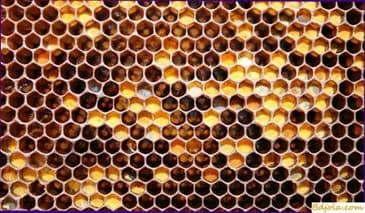
The bees primarily consume freshly introduced pollen. But if it is not enough or the shoulders can not make it because of the bad weather, or there are no flowering pollen plants, they consume the stocks of perga, built in the nest.
In the spring, bees often feel a lack of pollen. The main spring dustcens (hazel, willow, birch, etc.) often bloom under adverse weather conditions and are not fully used by bees. If there is a lack of pollen in nature and there is no stock in the honeycomb, then bees grow less brood, bring out smaller bees.
In order to ensure that the bees can continuously feed the larvae in the spring, it is necessary to leave 2-3 pairs of perga in the nest of each family in the autumn. In areas where there is always a lack of pollen in the spring, you should specially store and store honeycombs from the hives outside the hive. For this purpose, among the summer, during a good pollen transfer, at the next inspection of families, 1-2 honeycombs, well filled with perga (but without brood), are taken from the nests. This selection of pengu bee quickly replenished with pollen brought from the field. Excess honeycomb with perga can be selected in the autumn after the end of the honey crop, when the nests are cut in families.
Much better stored honeycomb with Perga in the cells, topped with honey, and sealed. Such honey-pear honeycombs are especially good for early spring brood rearing. To prepare honey-pepper honeycombs, it is necessary, with the onset of the main honey collection for several hives with strong families, to put nest boxes (or 2 stores) and place in them the pearl honeycombs selected from the lower casings. With the onset of honey bees, honeybees will be filled with honey and sealed, after which they are collected and placed in boxes or chests. Such honey-pergola honeycombs in the early spring period are distributed to bees.
Storage of honeycomb with Perga during the winter requires a lot of attention. Pergue can not be stored in a very humid room, as it is easily covered with mold and spoiled. You can not store it in too dry a place: it dries up and turns into dense lumps, which bees can not use. We should also not allow perga to freeze in winter, as it loses vitamins and other biologically active substances and becomes inferior.
For better storage of selected honeycombs with perga, as well as spare frames with honey, prepare dense painted outside boxes, chests or hulls of empty hives. They are installed in a cool, but necessarily dry place, preferably with a uniform temperature of 1 to 8 њ C (at this temperature, the wax moth will not develop in the honeycombs). Boxes and chests make the size of the frames placed in 1 or 2 rows. For hanging frames, wooden slats are nailed to the walls of the boxes. The frames are placed at a distance of 8-10 mm from one another. The box or chest is closed with a tight lid and all the slits are sealed with paper.
In this form, at a temperature of 2 to 8 њ C, the pepper is well preserved until the spring of the following year. It is also important that at a temperature not exceeding 8 њ C, a wax moth can not develop in honeycombs, the larvae of which destroy both honeycomb and pergus.
In the absence of a suitable room for storing honeycomb with pergoy, you can fill up the cells with powdered sugar. The layer of powder protects the perga from direct exposure to atmospheric moisture. In spring, the cells are sprinkled with water and put honeycomb into the nests. The sugar powder dissolves, and the bees take it, and then use the perga folded in the cells.
Honey combs with perga are placed in the spring in the hive with the expansion of the nests. It is best to put them next to the brood. Although on the overwintering perge bees grow half the brood than on freshly bred, but nevertheless the presence of perga in the nests promotes the growth of families.
Sometimes bees collect large excesses of Perga. They fill the pile with a lot of honeycombs, reducing the space needed to grow the brood and fold the honey. To release the honeycombs from excess peps, the cells are poured with warm water, so that the pepper swells, then water and a part of the perg are pumped out on the honey extractor.
If a honeycomb with perga is simply dropped into the water, the cells will be filled with air and water will not penetrate inside the cells. Therefore, it can be poured only by thin trickles with the help of the spraying device “Rosinka”. When processing large batches of honeycombs, it is possible to arrange water pouring in a less labor-intensive way. Honeycombs within the framework are installed in the usual vertical position at a distance of 8-10 cm from each other in dense boxes or metal baths. Then, from the higher vessel with warm water through a thin rubber hose, slowly (for 8-10 hours) let the water into the box with honeycomb. In this case, water will displace the air and enter most of the cells. In a day, water and perga are pumped out on a honey extractor. With insufficient extraction of Perga, it is soaked again.
Платформы содержание пчел. Как навить пружину на токарном станке.
Feeding base of beekeeping